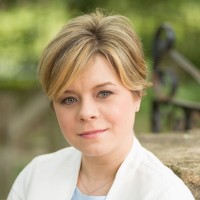The key to advancing HIV cure research? Integrating biomedical and sociobehavioral approaches
November 8, 2019
In the search for an HIV cure, how can researchers translate basic discoveries into clinical research that will have real-world applications? According to faculty from the UNC Gillings School of Global Public Health, the key is integrating behavioral and social sciences research with biomedical research.

Dr. Karine Dubé
Karine Dubé, DrPH, a sociobehavioral researcher and assistant professor in the Public Health Leadership Program at the Gillings School, is lead author of “Applying the Behavioral and Social Sciences Research (BSSR) Functional Framework to HIV Cure Research,” published on Oct. 30 in the Journal of the International AIDS Society. Dubé is also the lead author of “The Dose Response: Perceptions of People Living with HIV in the United States on Alternatives to Oral Daily Antiretroviral Therapy,” published online Oct. 14 in AIDS Research and Human Retroviruses.
Dubé encourages a Behavioral and Social Sciences Research functional framework that offers a more thorough understanding of the human and social dimensions related to researching possible HIV cure or remission regimens.
“We need to integrate the biomedical and behavioral sciences,” she says. “We must strengthen our cure-related studies to make sure they are more patient-centered instead of product-centered. We should look at these studies from the point of view of human-centered design that is scalable and also acceptable for those we wish to cure.”
Certain drugs used in HIV cure studies pose potential short-term and long-term risks and side effects. Some studies may require participants to discontinue their current treatment regimen to test new interventions, which can lead participants to worry about their safety. Downsides to participation — such as exacerbating the additional medical concerns of aging people living with HIV — can affect whether patients will be able to continue with a study.
Offering counseling and support interventions to address the psychosocial needs of participants, providing information on risk reduction in the course of any HIV treatment interruptions, and engaging HIV care providers’ perceptions and attitudes about their patients’ participation in cure research should all be a central part of research aimed toward an HIV cure.
“Including this functional framework can help researchers understand the research context and risk behaviors, factors that affect participant recruitment and retention, and the involvement of diverse communities,” says Dubé. “Understanding participant experiences informs cure efforts in meaningful ways and can improve the existing strategies for finding a cure.”
Dubé says HIV prevention research has strong models where this kind of integration is already taking place and is leading participants to better adhere to prevention strategies. In order to bring HIV cure discoveries to those who need it most, Dubé believes researchers must consider participants’ motivations, perceptions, needs and desires. Asking about their lived experiences and how participating in cure research will impact their life and health status is key to finding new HIV cure or remission methods that will not only work, but also be adhered to and tolerated by people with HIV.
Examples of such questions include: “What language should be used, and how does it make people living with HIV feel? How will changing their current treatment in order to work toward a cure impact them physically, emotionally and socially? What kinds of support do they need as they follow a regimen they aren’t sure will work?”
The functional framework Dubé describes provides a way to demystify sociobehavioral research, identify advances, gaps and opportunities for a multidisciplinary research agenda, and ensure any possible regimens relate to patients in the real world in ways that are safe, acceptable and workable in their everyday lives.
This framework includes four key domains:
- Basic Behavioral and Social Sciences Research, which explains core behavioral and social factors;
- Elemental Behavioral and Social Sciences Research, which advances behavioral and social interventions;
- Supportive Behavioral and Social Sciences Research, which strengthens biomedically focused clinical trials; and
- Integrative Behavioral and Social Sciences Research, which builds multidisciplinary approaches for real-world implementation of HIV cure regimens.
In Dubé’s paper on “The Dose Response,” researchers show how people living with HIV would prioritize improvements in HIV therapeutics, as well as how supportive Behavioral and Social Sciences Research can help guide the development of HIV cure research strategies.
The study showed statistically significant differences in how men and women perceive the risks and preferences of HIV control strategies, as well as identified possible psychosocial factors that could make someone willing to switch to new HIV treatment or remission research options.
“As the HIV treatment and remission field become more crowded, BSSR can help prioritize strategies that ensure regimens remain acceptable and meaningful to patients,” says Dubé.
Contact the Gillings School of Global Public Health communications team at sphcomm@listserv.unc.edu.
